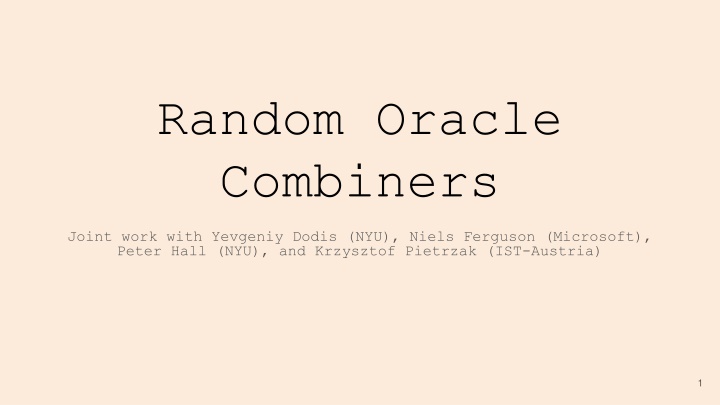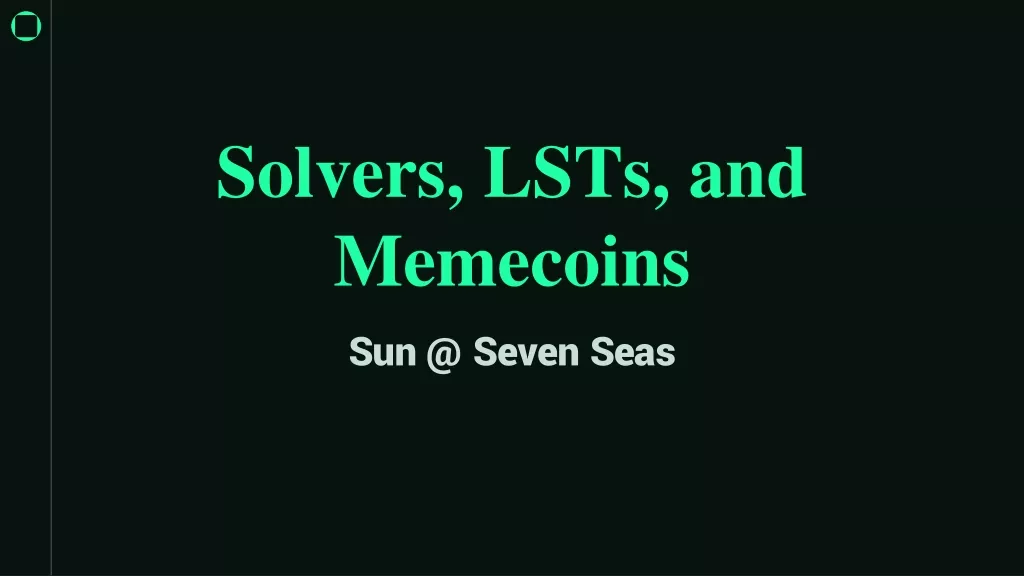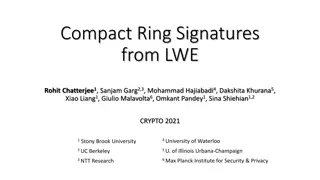
Random Oracle Combiners in Cryptography
Explore the world of random oracle combiners in cryptography, their role, properties, and how they are judged. Learn about multi-property combiners and the challenges of short combiners, along with breakthroughs in breaking the concatenation barrier. Discover how random oracles can come to the rescue in cryptographic schemes.
Download Presentation

Please find below an Image/Link to download the presentation.
The content on the website is provided AS IS for your information and personal use only. It may not be sold, licensed, or shared on other websites without obtaining consent from the author. If you encounter any issues during the download, it is possible that the publisher has removed the file from their server.
You are allowed to download the files provided on this website for personal or commercial use, subject to the condition that they are used lawfully. All files are the property of their respective owners.
The content on the website is provided AS IS for your information and personal use only. It may not be sold, licensed, or shared on other websites without obtaining consent from the author.
E N D
Presentation Transcript
Random Oracle Combiners Joint work with Yevgeniy Dodis (NYU), Niels Ferguson (Microsoft), Peter Hall (NYU), and Krzysztof Pietrzak (IST-Austria) 1
What are combiners? Welcome Hello! Check out CoinHash. I don t trust that, can you use SHA3? Well I don t trust SHA3. 2
What are combiners? SHA3 CoinHash Combiner CoinSHA 3
What are combiners? Ch,gis a secure hash function as long as h or g is secure . h g Combiner Ch,g 4
How do we judge combiners? 1. Output length 2. Security properties they work for 3. Efficiency (number of calls to h and g) 5
PART 1 Prior Work 6
Focused on Concrete Security Properties Collision resistance combiner Ch,g(m) = h(m) || g(m) One-wayness combiner Ch,g(m1, m2) = h(m1) || g(m2) Pseudorandomness combiner (h and g keyed) Ch,g(m) = h(m) g(m) 7
Multi-Property Combiners [FL08,FLP09] Multi-Property Preserving combiner for collision resistance, pseudorandomness, target collision resistance, MAC, one-wayness. Output length: 2n Efficiency: Calls each hash function 3 times 8
Short Combiners? For just collision-resistance, can we get output length to n? [BB06][Pietrzak07/08] IMPOSSIBLE! 9
Big Question: Can we break the concatenation barrier? Partial Answer: YES Cryptophia s Short Combiner [Mittelbach13][MP14] 10
Random Oracles to the Rescue What if we assume the secure hash function h is a random oracle H? Maybe the stronger (than CR) assumption on h can overcome the concatenation barrier. How to model the insecure hash function g? 11
Cryptophias Short Combiner Modelling gH H Combiner CH,gH is CR/pseudorandom/ (in ROM) 12
Efficiency of Cryptophia Construction WOO-HOO! 1. Output length Good enough? Same as original 2. Security properties Random Oracle One-way/CR/MAC/Pseudorandom 3. Efficiency 2( /n+1) 2( /n+1) calls, where is the input length Optimal? 13
Are Concrete Properties Enough? No! Many real-world applications need stronger properties. Fiat-Shamir Hash-then-sign Fujisaki-Okamoto Bitcoin ... 14
PART 2 Random Oracle Combiners 15
Random Oracle Combiner gH H Combiner CH,gH is CR/pseudorandom/ (in ROM) is a Random Oracle? 16
Indifferentiability [MRH04,CDMP05] Formalizes what it means for a construction CHto be a random oracle in Ideal(H) Has a nice composition theorem for single-stage security games ?. ?(F) secure in ROM(F) CHindifferentiable from F ?(CH) secure in Ideal(H) 17
Random Oracle Combiners H H gH gH Combiner Combiner CH, gH CgH,H Indifferentiable from Random Oracle 18
Random Oracle Combiners Don t Exist : ( Theorem: Random oracle combiners don t exist. Deterministic Attack: Common preamble for all inputs to gH Hardwire random g1,...,gpoly( ). Evaluate CH,gi(0) and Cgi,H(0). If the first bit of any of these is 1, use the corresponding gi. Claim: Either bias C(0) to 1, or it was already biased to 0 19
Salt to the Rescue! H H gH gH Combiner Combiner CH, gH CZH, gH CH, gH CZH, gH Indifferentiable from Random Oracle Note: Z is chosen after g is fixed, but is given to distinguisher 20
PART 3 The Construction 21
Construction CZ1,Z2h,g(M)=h(M,Z1) g(M,Z2) |Z1|=|Z2| |M|+ Theorem: CZ1,Z2h,g(M) is a random oracle combiner. 22
Proof of Main Theorem Construction: CZ1,Z2H, gH(M)=H(M,Z1) gH(M,Z2) Main claim: For all M, gH(M,Z2) never calls H( ,Z1) on any input. H (M):=H(M,Z1) is a random oracle independent of gH(M,Z2) C(M) = RO(M) IndependentFunction(M) ~ RO(M) 23
Proof of Main Claim Size T 2|M| gH(1,Z2) gH(2,Z2) gH(2|M|,Z2) Query 1 H(71,123) H(16,553) H(41,333) Query 2 H(12,242) H(80,227) H(97,657) Query T H(42,124) H(11,839) H(18,803) Pr[H( ,Z1) queried by gH( ,Z2)] T 2|M|/2|Z1| T/2 24
How do we judge combiners? 1. Output Length Same as original 2. Security Properties Random Oracle Combiner 3. Efficiency One call Construction: CZ1,Z2h,g(M)=h(M,Z1) g(M,Z2) 25
PART 4 Real-world hash functions 26
Real World Hash Functions h* h Merkle Damg rd: h*(x1, , xm) = h(xm, h(xm-1, , h(x1, 0)...)) x1 x2 x1 h h h h*(x) ... 0 27
What about our combiner? What happens when we plug in Merkle Damg rd hash functions h*,g* into our combiner? CZ1,Z2h*,g*(M)=h*(M,Z1) g*(M,Z2) Big Q: Is this secure ? Formally, is DZ1,Z2h,g(M)=h*(M,Z1) g*(M,Z2) a secure RO combiner in our model? 28
Attempt 1: Use Composition DZ1,Z2h,g(M)=h*(M,Z1) g*(M,Z2) EZ1,Z2h,g(M)=h*(Z1,M) g*(Z2,M) CZ1,Z2h,g(M)=h(M,Z1) g(M,Z2) Prefix Construction C is RO Combiner Composition Lemma D is RO Combiner Combiner E is RO H*is [CDMP05] indifferentiable from RO :) ? Only holds for single-stage games. Are we? Seems like we are done 29
Attempt 1: Use Composition EZ1,Z2h,g(M)=h*(Z1,M) g*(Z2,M) CZ1,Z2h,g(M)=h(M,Z1) g(M,Z2) Theorem: E is not a RO Combiner. :( Intuition: h*(Z1,M) = h*(h*(Z1),M) and so a long salt acts like a short one, leading to attack. 30
Attempt 2: Direct Proof? DZ1,Z2h,g(M)=CZ1,Z2h*,g*(M)=h*(M,Z1) g*(M,Z2) Big Q: Is D a RO Combiner? 31
Attempt 3: Cryptophia Style DZ1,Z2h,g(M)=CZ1,Z2h*,g*(M)=h*(M,Z1) g*(M,Z2) Can we show DZ1,Z2H,gsatisfies collision-resistance? Note: Composition still doesn t apply (so cannot get less efficient result from [Mittelbach13]+[CDMP05]) 32
Practical Result Informal Theorem: DZ1,Z2h,g(M)=h*(M,Z1) g*(M,Z2) |Z1|=|Z2| |M|(1 + o(1))+ satisfies collision resistance as long as one of h or g is instantiated with a random oracle. 33
Intuition Key property of MD: For any X, any process which computes H*(X) must query each round of MD. If attacker finds a collision D(M)=D(M ), then either g*(M,Z2) or g*(M ,Z2) must compute H*(M,Z1). By key property Random (Z1, Z2) can be described by Z2 + M/M + index of queries made by g* , which is < |Z1|+|Z2| 34
Open Questions 1. Is D a random oracle combiner (i.e. does our construction compose with MD transform)? 2. Is there any combiner which composes nicely with (restricted) indifferentiability? 3. Can we construct a random oracle combiner that only uses bits of randomness? 35
Thank you! 36
Why is indifferentiability hard? Recall monolothic combiner proof showed that g(M,Z2) is independent of H( ,Z1) Not true here! g*(M,Z2) is NOT independent of H*( ,Z1). For example, if M = H*(0, Z1<k) || Z1kthen g*(M, Z2) can easily compute H*(0, Z1). 37






















